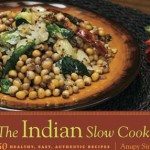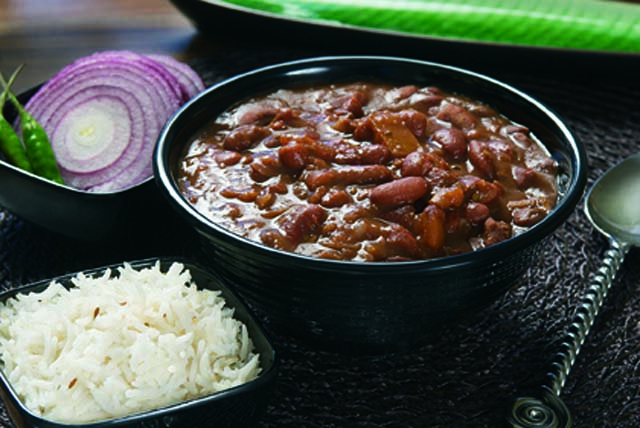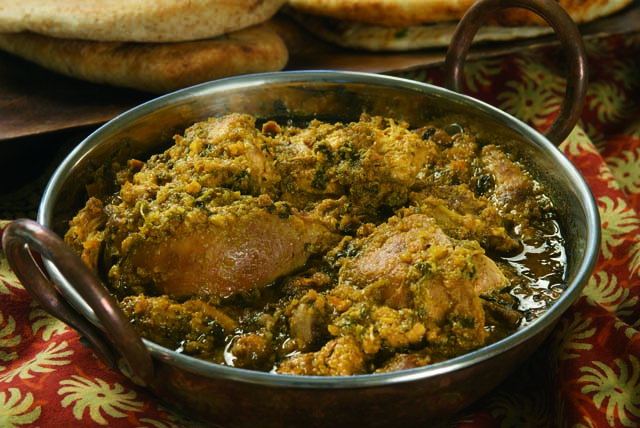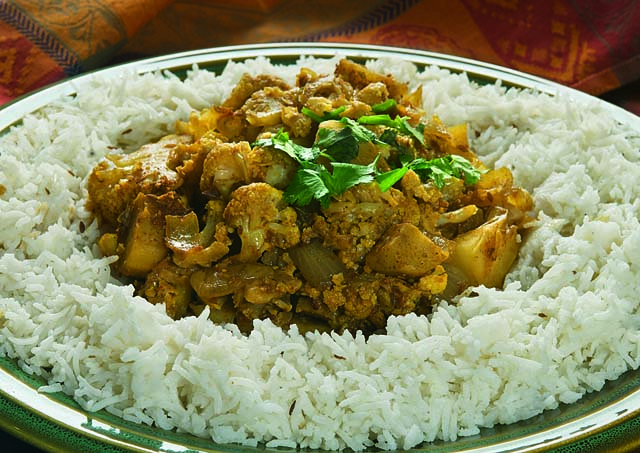
Indian food cooked in the Slow Cooker…
What can be more soul-satisfying than legumes and lentils slow-cooked to creamy perfection, with a touch of Indian spices? In ‘The Indian Slow cooker’ Anupy Singla shares 50 healthy authentic recipes passed down in her family and which work well for busy lifestyles. With people increasingly concerned about heart disease, diabetes and obesity, these light, nutrient rich meals are a welcome addition to healthy and tasteful options.

The Indian Slow Cooker
Punjabi Curried Kidney Beans
Rajmah | Slow cooker size: 5-quart • Cooking time: 11 hours on high • Yield: 10 cups (2.37 L)
Rajmah, a North Indian version of chili or red beans and rice, is the quintessential comfort food for Punjabis. Ask anyone from that region, and she’ll tell you she grew up eating these hearty beans over rice in her home as a quick Sunday lunch or in her college hostel. It’s not a dish that’s usually considered refined enough to be served in a restaurant, but it is a classic. It’s even better when served over a bed of rice with some savory, tangy yogurt on the side. I remember one buddy in graduate school at the University of Hawaii who had just arrived from India and was so desperate to eat rajmah that he substituted ketchup for tomatoes. I wouldn’t recommend such shortcuts, nor would I recommend using canned beans or cream, as some recipes suggest. Keep it simple, and I guarantee you’ll make this dish over and over again.
3 cups (603 g) dried red kidney beans, cleaned and washed thoroughly
1 medium yellow or red onion, peeled and roughly chopped
2 medium tomatoes, diced
1 (2-inch [5 cm]) piece ginger, peeled and chopped or grated
3 cloves garlic, peeled and chopped or grated
4–6 green Thai, serrano, or cayenne chilies, stems removed, chopped
3 whole cloves
1 (2–4 inch [5–10 cm]) cinnamon stick
1 tablespoon (15 mL) cumin seeds
1 tablespoon (15 mL) red chili powder
2 tablespoons (30 mL) salt
1 teaspoon (5 mL) turmeric powder
1 teaspoon (5 mL) garam masala
9 cups (2.13 L) water
½ cup (100 g) chopped fresh cilantro
1. Put the kidney beans, onion, tomatoes, ginger, garlic, green chilies, cloves, cinnamon stick, cumin seed, red chili powder, salt, turmeric, garam masala, and water in the slow cooker.
2. Cook on high for 11 hours, until the beans break down and become somewhat creamy.
3. Remove and discard the cloves (if you can find them!) and cinnamon stick. If the rajmah is not creamy enough, take an immersion blender and press it two or three times to break up some of the beans. If using a blender, take out about 1 cup (237 mL) and process in the blender, then return it to the slow cooker. Be careful not to process all of the beans; most of them should remain whole.
4. Stir in the cilantro. Serve over a bed of basmati or brown rice with a side of raita and an Indian salad.
Try This! After cooking, turn off the slow cooker and add 1 cup (237 mL) plain yogurt. Stir well and let the slow cooker sit with the lid on for about 10 minutes. This adds a unique tang.
To make this dish in a 3½ quart slow cooker, halve all the ingredients and proceed with the recipe. A half recipe makes 5 cups (1.18 L).

The Indian Slow Cooker:
Traditional Chicken Curry
Slow cooker size: 5-quart • Cooking time: 8 hours on low • Yield : 6-8 servings
When most people think of Indian food, the first dish that comes to mind is a good chicken curry. Because I never ate this dish growing up, I relied on my husband’s childhood version for this recipe. He says the best chicken curry is made with a rich sauce and no vegetables. Though many recipes call for chopped cauliflower or carrots, I’ve tried to remain true to his tastes for this recipe.
3 pounds (1.36 kg) skinless whole chicken, cut in about 8 pieces including the breast, legs, and wings (boneless can also be used)
1 large or 2 medium yellow or red onions, peeled and chopped into 8 pieces
2 medium tomatoes, quartered
1 (4-inch [10 cm]) piece ginger, peeled and chopped into 1-inch (2.5 cm) pieces
10 cloves garlic, peeled
1 tablespoon (15 mL) salt
1 tablespoon (15 mL) turmeric
1 tablespoon (15 mL) garam masala
¼ cup (59 mL) vegetable or canola oil
1 cup (237 mL) plain yogurt
1 tablespoon (15 mL) red chili powder
1 cup (237 mL) dried methi leaves
1 (2–4 inch [5–10 cm]) cinnamon stick
4 green cardamom pods
4 cloves
4–6 green Thai, serrano, or cayenne chilies, stems removed, halved lengthwise
½ cup (118 mL) boiling water (optional)
½ cup (100 g) fresh cilantro, chopped
1. Put the chicken in the slow cooker. (If the meat was frozen, make sure it is thoroughly defrosted. Never use frozen foods in a slow cooker, because it takes too long to raise the heat to an appropriate level for safe, bacteria-free cooking.)
2. In a food processor, grind the onion, tomato, ginger, and garlic until smooth. This may take a few minutes, so be patient. You want the paste to be as smooth as possible.
3. Transfer the paste to a bowl. Whisk in the salt, turmeric, garam masala, oil, yogurt, red chili powder, and methi. Pour this mixture over the chicken.
4. Add the cinnamon stick, cardamom pods, cloves, and green chilies. Mix gently.
5. Cook on low for 8 hours. If you want more broth with your chicken add the water toward the end of the cooking time. Remove the whole spices.
6. Garnish with cilantro and serve over bed of basmati or brown rice or with roti or naan.
Try This! For you vegetarians out there, substitute seitan for the chicken and follow the same steps. Although seitan does not need to cook as long as the chicken would, stick to the cooking time given. The masala still needs to cook thoroughly. If you are concerned that the seitan may get tough, add it in after four hours of cooking.
To make this dish in a 3½-quart slow cooker, halve all the ingredients and proceed with the recipe. A half recipe makes 3-5 servings.
The Indian Slow Cooker:
Spiced Cauliflower and Potatoes
Aloo Gobi | Slow cooker si ze: 4- or 5-quart • Cooking time: 3 hours on low • Yield: 7 cups (1.66 L)
Until I made this myself in the slow cooker, I refused to believe my mother-in-law when she said it was possible. I also wondered why I wouldn’t just make this dish on the stovetop, where it could sit for less time. After trying it once, I realized the answer: because I can now stick it in my slow cooker and go about my day. I don’t think twice about the kids near the stove or anything burning. My father—the real foodie of the family—also wouldn’t believe this dish could be made well in the slow cooker, so he just had to try it himself. He had me on the phone in excitement for half an hour after trying it for the first time. He insists on the tomato. I like it better without. You be the judge.
1 large cauliflower, washed and cut into 1-inch pieces (about 8 cups/1.89 L)
1 large potato (russet or yellow), peeled and diced (about 2 cups/473 mL)
1 medium yellow or red onion, peeled and coarsely chopped
1 medium tomato, diced (optional)
1 (2-inch [5 cm]) piece ginger, peeled and grated
3 cloves garlic, peeled and chopped, minced, or grated
3–4 green Thai, serrano, or cayenne chilies, stems removed, chopped or sliced lengthwise
1 tablespoon (15 mL) cumin seeds
1 tablespoon (15 mL) red chili powder
1 tablespoon (15 mL) garam masala
1 tablespoon (15 mL) salt
1 teaspoon (5 mL) turmeric powder
3 tablespoons (50 mL) vegetable or canola oil
1 heaping tablespoon (20 mL) fresh cilantro, chopped
1. Put all the ingredients except the cilantro in the slow cooker. Mix well.
2. Cook on low for 3 hours. Mix once or twice during cooking, especially in the beginning. Eventually the cauliflower will release enough liquid to prevent anything from sticking to the sides of the slow cooker.
3. Add cilantro. Mix well but gently so as not to break up the cauliflower. Serve with roti or naan and a side of onion and cucumber salad.
To make this dish in a 3½-quart slow cooker, halve all the ingredients and proceed with the recipe. A half recipe makes 4 cups (946 mL).
Recipes from The Indian Slow Cooker: 50 Healthy, Easy, Authentic Recipes By Anupy Singla ( Agate Publishing)
Related Article:
Anupy Singla’s The Indian Slow Cooker


1 Comment
Don’t you think cooking veggies for so long will make them lose their nutrition?